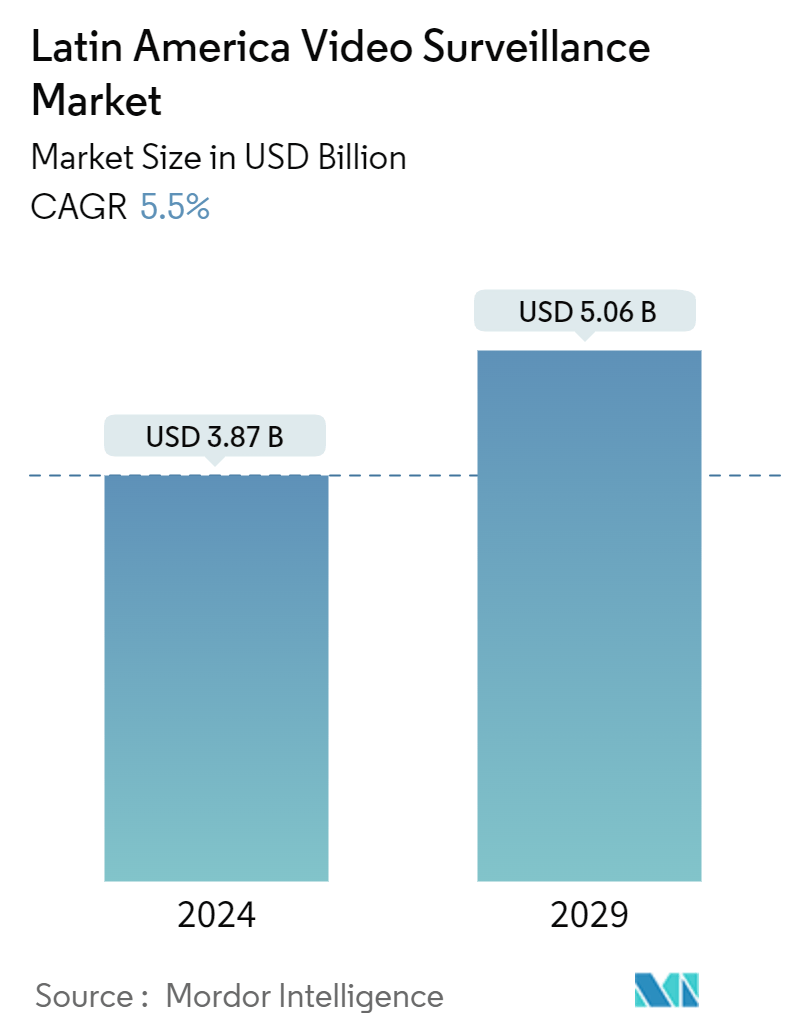Market Size of Latin America Video Surveillance Industry

| Study Period | 2019 - 2029 |
| Base Year For Estimation | 2023 |
| Market Size (2024) | USD 3.87 Billion |
| Market Size (2029) | USD 5.06 Billion |
| CAGR (2024 - 2029) | 5.50 % |
| Market Concentration | Low |
Major Players
*Disclaimer: Major Players sorted in no particular order |
Latin America Video Surveillance Market Analysis
The Latin America Video Surveillance Market size is estimated at USD 3.87 billion in 2024, and is expected to reach USD 5.06 billion by 2029, growing at a CAGR of 5.5% during the forecast period (2024-2029).
- Video surveillance systems capture images and videos inside or outside of an establishment that can be stored or sent over related communication networks to be analyzed for security purposes. These systems/solutions can be used in nearly any environment, becoming an essential infrastructural requirement for all organizations globally to maintain specific security and monitoring measures. As a result, recent years have witnessed a dramatic increase in demand for security applications such as video surveillance to monitor and record corporate houses, borders, transportation infrastructure, and other public and private institutions/infrastructures.
- Considering the evolving dynamics of the Latin American market, video surveillance systems are significantly growing in demand. According to the Population Reference Bureau, Latin America is highly urbanized. As of 2023, about 82% of the population in Latin America lived in urban areas.
- As population concentration in urban areas is usually high, it often leads to several issues, such as growth in crime rates, which require advanced solutions to increase the sense of security among citizens. Also, video surveillance systems help authorities analyze/track if people are following the rules such as traffic rules. In recent years, governments have taken initiatives across several Latin American countries to improve law and order, driving opportunities in the market.
- The development of smart cities is one of the key initiatives driving the demand for video surveillance solutions in Latin America. Several Latin American countries have become a part of this initiative and have launched innovative city projects across their respective countries. For instance, in February 2024, newly elected members of several Colombian cities visited Korea to advance their understanding of smart city initiatives started by Seoul, enhance partnerships with the private sector, and foster connections with local governments.
- Also, a higher crime rate across several Latin American countries is another major factor encouraging law enforcement authorities to invest in advanced security and surveillance systems. As video surveillance is considered among the most effective solutions to curb unlawful activities, such trends will also support the market's growth in the region.
- However, the higher cost of advanced video surveillance systems, such as IP-based, AI-based, or hybrid security cameras, continues to remain among the major factors challenging the market's growth in Latin America as the region has a relatively lower economic growth compared to developed or other developing regions such as Asia-Pacific.
Latin America Video Surveillance Industry Segmentation
Video surveillance systems leverage cameras or networks of camera systems and related hardware to capture footage in specific areas for live viewing or recording for later review. These systems transmit footage from cameras to centralized monitoring devices, servers, or cloud storage for future access or analysis.
The Latin American video surveillance market is segmented by type and end-user vertical. By type, the market is segmented by hardware, software, and services; the hardware segment is further segmented into camera and storage. The cameras segment is further subsegmented into analog, IP cameras, and hybrid. By software, the market is segmented into video analytics and video management software. By End-user vertical, the market is segmented into commercial, infrastructure, institutional, industrial, defense, and residential. By country, the market is segmented into Brazil, Mexico, Argentina, and the Rest of Latin America. The market sizes and forecasts are provided in terms of value (USD) for all the above segments.
| By Type | ||||||||
| ||||||||
| ||||||||
| Services (VSaaS) |
| End-user Vertical | |
| Commercial | |
| Infrastructure | |
| Institutional | |
| Industrial | |
| Defense | |
| Residential |
| By Country | |
| Brazil | |
| Mexico | |
| Argentina | |
| Rest of Latin America |
Latin America Video Surveillance Market Size Summary
The Latin America video surveillance market is experiencing significant growth, driven by the increasing need for security solutions across urbanized areas. As urban populations rise, so do concerns about crime rates, prompting both public and private sectors to invest in advanced surveillance systems. These systems, which include IP-based and AI-driven cameras, are essential for monitoring and securing various environments, from corporate offices to public spaces. The development of smart cities further fuels this demand, as countries in the region implement innovative projects to enhance urban safety and efficiency. Despite the high costs associated with these advanced systems, the market continues to expand, supported by government initiatives and the growing awareness of security needs.
Brazil stands out as a key player in the region's video surveillance market, with significant investments in security infrastructure, such as facial recognition technology and citywide surveillance systems. The competitive landscape is marked by the presence of numerous vendors, including major players like Eagle Eye Networks and Hikvision, who are actively expanding their market presence through strategic initiatives. The proliferation of smart devices and the adoption of IoT in surveillance solutions are also contributing to market growth, as they offer enhanced monitoring capabilities and ease of use. Overall, the Latin American video surveillance market is poised for continued expansion, driven by urbanization, crime prevention needs, and technological advancements.
Latin America Video Surveillance Market Size - Table of Contents
-
1. MARKET INSIGHTS
-
1.1 Market Overview
-
1.2 Industry Attractiveness - Porter's Five Force Analysis
-
1.2.1 Bargaining Power of Suppliers
-
1.2.2 Bargaining Power of Buyers
-
1.2.3 Threat of New Entrants
-
1.2.4 Threat of Substitute Products
-
1.2.5 Intensity of Competitive Rivalry
-
-
1.3 Industry Value Chain Analysis
-
1.4 Technology Snapshot
-
1.5 Impact of Macroeconomic Trends On the Market
-
-
2. MARKET SEGMENTATION
-
2.1 By Type
-
2.1.1 Hardware
-
2.1.1.1 Camera
-
2.1.1.1.1 Analog
-
2.1.1.1.2 IP Cameras
-
2.1.1.1.3 Hybrid
-
-
2.1.1.2 Storage
-
-
2.1.2 Software
-
2.1.2.1 Video Analytics
-
2.1.2.2 Video Management Software
-
-
2.1.3 Services (VSaaS)
-
-
2.2 End-user Vertical
-
2.2.1 Commercial
-
2.2.2 Infrastructure
-
2.2.3 Institutional
-
2.2.4 Industrial
-
2.2.5 Defense
-
2.2.6 Residential
-
-
2.3 By Country
-
2.3.1 Brazil
-
2.3.2 Mexico
-
2.3.3 Argentina
-
2.3.4 Rest of Latin America
-
-
Latin America Video Surveillance Market Size FAQs
How big is the Latin America Video Surveillance Market?
The Latin America Video Surveillance Market size is expected to reach USD 3.87 billion in 2024 and grow at a CAGR of 5.5% to reach USD 5.06 billion by 2029.
What is the current Latin America Video Surveillance Market size?
In 2024, the Latin America Video Surveillance Market size is expected to reach USD 3.87 billion.

